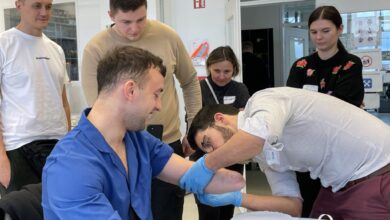By TSD Newsdesk
Dr. Andre Perry of the Brookings Institute and the Hechinger Report delved into his research on race and structural inequality, education and economic inclusion during a visit to LeMoyne-Owen College last week.
Perry’s visit to Memphis’ only HBCU (historically black college and university) included an interview with Brian Clay of “The Brian Clay Chronicles” for an upcoming podcast of the Big Business of Poverty. The New Tri-State Defender’s media partnership with the developers of “The Brian Clay Chronicles” netted this Q&A.
In this conversation, Perry touched upon his most recent scholarship – an analysis of “majority black places and institutions in America, focusing on highlighting valuable assets worthy of increased investment.”
Brian Clay – In the book, “The Mis-Education of a City,” which is pretty much an anthology of when you served as the CEO of the Capital One school in New Orleans, … basically what you’ve said in there is when it comes to each case, and especially with your work in New Orleans, it was about changing thought there. Where a city after Katrina and the storms there had to re-engineer their thought process about education. Tell me a little bit about that.
Dr. Andre Perry – This actually is one of the reasons why I do my current work on economic development. I often say kids don’t live in the schools, they live in the communities, and we have got to recognize the breadth of the experiences that kids go through that manifests itself at school. …
And you’re not going to fix those things in a child, per se. And that’s what we attempt to do; we try to fix children through punishment, typically. We try to punish problems out of them. But the reality is that if you want to change children and behaviors that are not conducive for academic success, you have to change the root causes. And a lot of that is the structural inequality that persists in majority black places. …
I’m presenting…this evening, and you’ll hear me use the refrain, “There’s nothing wrong with black people that ending racism can’t solve.” It’s my belief, predicated on data, that if you move policy, behaviors will change. …
Likewise, many of the successes we see in many populations are not the result of bootstrapping and individual effort. But it is the result of the direct investment in the people who do policy. And that’s what I’m trying to do. When I worked in schools, we did everything to fix children; we did everything to fix parents. We did little to change the overall setting that they lived in. So my work now is about changing the setting that people live in.
B.C. – … Do you think 1954, Brown vs (Topeka) Board of Education (case that outlawed public school segregation)…do you think we were trying to fix people then? Or was it a policy effort?
Dr. A.P. – I think, in the main, what we wanted to do is get to the source of inequality, and that was segregation. Now, what we did do is assume that white schools are better, and that’s a mistake. What they were, they were better resourced. So the problem of moving kids out of their communities and into others led to a whole other level of divestment. … But busing was not the solution that they thought it would be; primarily because you’re not trusting the assets that you had.
B.C. – …We’re so glad that you’re here at LeMoyne-Owen College. … Do you think that’s one of the things that we do value in the African-American community, our HBCUs?
Dr. A. P. – Well, black folk appreciate and value, but society does not. …When you look at the overall number of grants, federal grants they’ve received, when you look at the attention they receive relative to the production, they’re not getting the level of investment.
I did a study recently that looked at the number of STEM graduates and business graduates coming out of HBCUs. If employers really wanted to fill that sector, they could look to HBCUs in doing so. HBCU grads, particularly in the STEM field and the business field, are achieving at high levels. … particularly in the south, but they’re not being absorbed in the high growth sectors of the economy.
We know that people will cut their noses to spite their faces in terms of racism, but I think it’s more, in this regard, a level of evaluation. They don’t see the value that HBCUs add to society. If you were standing in a room with successful, whatever that means, black people, and you asked them where they went to school, and you asked did they go to an HBCU, invariably, most (in) the room will raise their hand.
It’s because they were nurtured in a caring environment, one that believed in them, one that addressed relevant issues in a diverse environment. When you go to an HBCU, we’re actually dealing with a diversity of black folk. … These are great places and they need to be rewarded.
B.C. – … (Your upcoming book) “Know Your Price” is a fascinating study because you take housing as your premise and you go into a certain comparison in where you live. …Tell us a little bit about that.
Dr. A.P. – So in the study, I looked at homes in majority black places, meaning the communities where the black population is greater than 50 percent and I compared those prices to homes and communities where the share of the population is less than 1 percent. …All majority black places, Memphis included. …
Most people understand that there are price differences, but most people will say, hey, that’s because education is worse and there’s more crime and the housing stock is worse. …I measured those things. …We control for them to get to an apples-for-apples comparison. So we found a black home that’s equivalent in certain conditions to a white home in certain conditions.
B.C. – What did you find?
Dr. A. P. – We found that homes in black neighborhoods are devalued by 23 percent, about $48,000 per home, about $156 billion of lost equity across the country. … (P)ut that in perspective, that would have paid for about 4.4 million startup, black-owned businesses based on the amount of startup capital that we open up businesses with. It would have funded eight million four-year degrees. …
It’s an incredible number. Those dollars are typically used for communities to pay for schools, better policing. It goes to people to deal with the invariable and inevitable shocks that occur. …
(W)hat racism does is robbing people of the opportunity to lift themselves. Whenever something goes wrong in our communities, we talk about there’s something wrong, there’s something broken in the home, that this person doesn’t have home training. We look at the commentary from our President, talking about rat-infested communities, projecting a negative air that there’s something going wrong with our leadership. No, we have strong assets in the community, they’re just devalued, taking away our opportunity to lift ourselves.
Remember, whites were in similar position, and they still are in places. … In the Great Depression they were so in mass, but we used federal policy to bail people out. …Federal policy gave people an opportunity to own a home, to build one. It wasn’t this miraculous bootstrapping …
But my study essentially looks at assets in majority black places. And I’m not going to stop with housing. I’m looking at businesses. I’m looking at education and other critical areas… Folks need to see that they have value; they have assets that we should be able to build upon.
B.C. – … What is the answer? How do we fix this?
Dr. A. P. – We have to bring value back to the community. You can do that in several ways, either encouraging micro loans to current homeowners so that they can fix up their properties and improve those conditions. I’m obviously encouraging long-term renters to become homeowners. We certainly need to give down payment assistance….
I’m also advocating for individual level resource development. … I’m also an advocate of making sure business owners and entrepreneurs get the kind of low interest loans to start business and trying to take risks.
But most importantly…we need to advocate for federal policy that will enable communities at a large scale to do all of these things.
So, I’m an advocate for federal policy…and…encouraging people to do all they can to leverage their own assets so that we can bring attention to the lack of federal and state investment in black communities.
This article originally appeared in the New Tri-State Defender





